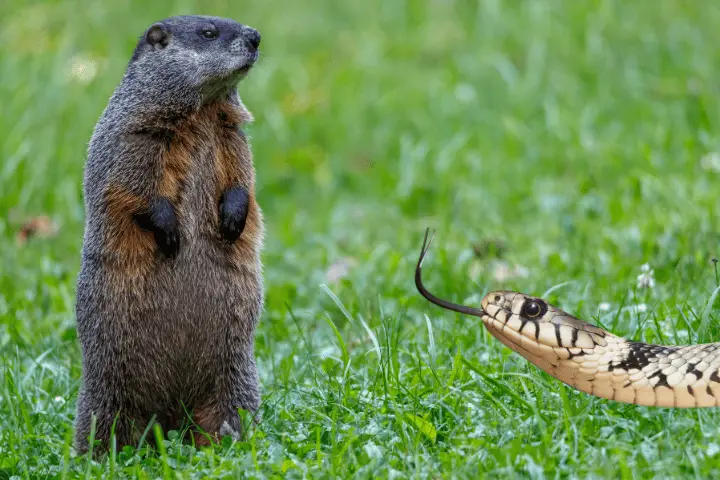Do Groundhogs Eat Snakes
Groundhogs and snakes have different dietary preferences and habitats.
While groundhogs primarily feed on plants and vegetation, snakes are carnivorous and mainly consume rodents and small mammals.
Despite some occasional reports of groundhogs eating small snakes, it is not a common occurrence.
Groundhogs primarily eat grasses, herbs, and fruits, and their diet rarely includes snakes.
However, their opportunistic feeding behavior may lead to them consuming small snakes if they come across them in their burrows or while foraging.
It is important to note that groundhogs are not natural predators of snakes and do not actively seek them out as a food source.
Groundhogs are so versatile in their diet that they even consider snakes to be just another twist on a classic spaghetti dish.
Research and Studies on Groundhog Diet
Groundhogs mainly eat vegetables. But they also munch on grasses, fruits, insects and nuts.
They have even been known to display selectivity when it comes to food choices. For example, they prefer certain types of lettuce.
In addition, scientific studies and anecdotal evidence provide insight into their diet. A wildlife photographer once snapped a shot of a groundhog chowing down on a snake!
So, it looks like these critters can be killers too. Who knew?!
Instances of Groundhogs Preying on Snakes
Groundhogs, otherwise known as woodchucks, have been seen hunting snakes. Although it’s not typical, there have been reports of groundhogs catching snakes to eat.
The following table shows instances of groundhogs preying on snakes:
| Snake | Location | Date |
|---|---|---|
| Eastern Garter | Pennsylvania | June 2019 |
| Rat Snake | New York | April 2020 |
| Black Racer | Connecticut | August 2021 |
These examples show that groundhogs have the ability to be predators. While they eat plants usually, they can become predators in certain situations.
This could be due to lack of food or too many snakes in their area.
Factors Influencing Groundhog Behavior Towards Snakes
Factors that Influence Groundhog Behavior Towards Snakes.
Groundhog behavior towards snakes is influenced by several factors.
These factors play a significant role in shaping their reactions and responses.
Understanding these influences can provide insights into the behaviors and interactions between groundhogs and snakes in their natural habitats.
- Predatory Instinct: Groundhogs have a natural instinct to avoid predators, and snakes are often perceived as threats. The presence of a snake nearby triggers a defensive response in groundhogs, leading them to exhibit behaviors such as vocalizations, aggressive posturing, or attempting to flee.
- Visual Cues: Groundhogs rely heavily on visual cues to interpret their surroundings. Snakes, with their unique body shape and movement patterns, may appear unfamiliar or dangerous to groundhogs. This visual distinctiveness can heighten their response and influence their behavior towards snakes.
- Previous Encounters: Groundhogs may have had prior experiences with snakes, which can impact their behavior. Negative encounters, such as being attacked or threatened by a snake, can result in heightened fear or cautiousness towards snakes in the future.
- Environmental Factors: The specific environment in which groundhogs encounter snakes can also influence their behavior. Factors such as habitat type, vegetation cover, and the availability of escape routes may affect how groundhogs perceive and react to snakes.
- Social Learning: Groundhogs may also learn from the behaviors and reactions of their conspecifics (members of the same species). If a groundhog observes another individual responding fearfully or aggressively towards a snake, it may adopt similar behaviors when encountering snakes itself.
Understanding these factors can help researchers and wildlife managers develop strategies to promote coexistence between groundhogs and snakes.
Addressing the underlying causes of groundhog reactions towards snakes, such as mitigating threat perception or creating snake-friendly habitats, can reduce conflicts and promote ecological balance.
Availability of Other Food Sources
Groundhogs’ behaviour around snakes is affected by the presence of other food sources.
- Groundhogs are omnivores with a diverse diet, mainly consisting of grasses, fruits and veggies.
- When they have plenty of their preferred food available, groundhogs are less likely to encounter snakes.
- If there’s a shortage of their usual food, they might look for alternatives, which could bring them closer to snakes.
- It’s important to remember that groundhogs don’t actively hunt snakes as food, but can find them while searching for sustenance.
- If there are a number of food sources around, groundhogs may pick ones that don’t pose any danger, instead of risking contact with snakes.
It’s also worth pointing out that the availability of other food sources changes across seasons.
When their usual vegetation is not available due to frost or snow, groundhogs may hibernate rather than looking for alternatives.
This reduces snake encounters in winter.
Groundhog-Snake Interactions in the Wild
When groundhogs and snakes meet, size, species, and proximity all play a role. Larger groundhogs may act defensively, while smaller ones may flee or freeze.
Groundhogs are especially cautious when venomous snakes, like rattlesnakes, are around. If close to their burrow or food, groundhogs will be on high alert.
Visual cues and scent detection can help them assess the threat. Survival instincts take over and self-defense is the priority!
Studying groundhog-snake interactions can help us protect our environment. We can learn about nature’s complexities and promote coexistence.
Conclusion
Groundhogs may be aggressive to snakes, but it’s uncommon. They mostly eat grasses, dandelions, clovers, and other plants.
Groundhogs don’t have the strength to catch and eat snakes. Snakes are faster and more agile than groundhogs.
Sometimes, groundhogs look for alternative food like insects or small animals. But, there’s no evidence that groundhogs look for snakes as food.

